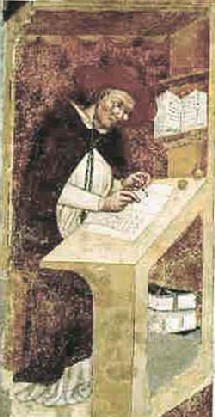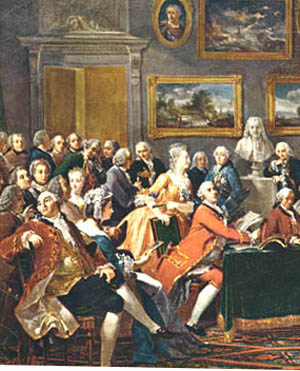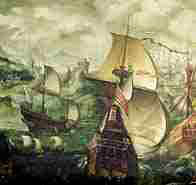 |
The Saint of the Day
Blessed Sebastian Valfré – January 30
Prof. Plinio Corrêa de Oliveira
Biographical selection:
Blessed Sebastian Valfré was born at Verduno, Alba, Italy, in 1629, and died in Turin, in 1710. He was an Oratorian priest and great apostle of charity, a virtue that characterized him all his life. He became famous for his sanctity, love for the sciences, and enormous correspondence with Bishops, priests and great personalities of the courts of his time.
Even amid all his duties, he left useful works such as Short Instruction for the Simple Man, which enjoyed a great success, Christian Exercises, and The Way to Sanctify War, written for those in the military. He was particularly devoted to Our Lady and used to start his courses teaching about her Immaculate Conception. In his religion classes, he used to spend six months teaching on the words of the Hail Mary. He used to recommend calling on the Guardian Angel in every need in life. His third great devotion was for the souls in Purgatory.
Comments of Prof. Plinio:
It is not very easy to comment on this selection because it draws a general picture of almost all the saintly priests of that time, a period that had many holy priests. I have already analyzed most of these characteristics for you at various times.

The Middle Ages produced great works on the ensemble of knowledge. Above, Cardinal Hugues of Provence
|
There is, however, a special point that distinguishes Blessed Valfré from the others, and that is his large written correspondence. To understand what this means, you need to consider that he lived in the time of Louis XIV, that is, at the apex of the Ancien Regime. In that epoch, the ways to communicate ideas were quite different from the ones we have today. They already prefigured today’s methods, but they were different.
In what sense did they prefigure modern communication? A curious thing in the history of inventions and their relation to social life is that one finds that the tendencies of men usually are already moving toward a new invention before its actual appearance.
When one analyzes the books of the Middle Ages, he finds collections of long works written on parchment that deal with very serious intellectual matters about the ensemble of human knowledge. It was the time of the Summae – of theology, philosophy, science, etc. That is, men were seeking to discover the great plans of God for the universe in order to love Him and to make the earth similar to Heaven.
When the printing press was discovered by Guttenberg, it generated smaller books. The subject matter became lighter, and the great ensembles on serious topics disappeared. The human spirit lost that medieval unity and became fragmentary, producing monographs on various subjects. The universal compilation gave way to specialized books and essays.
Another step down in this ladder was taken in the epoch of Louis XIV, which was the time of Madame of Sevigné, famous for her correspondence. At that time, letters acquired an importance parallel to books. With the roads more secure and the mail more reliable, the exchange of letters became more frequent. With this, the letter, lighter than the book, began to characterize a new method of conveying ideas.
There were two kinds of letters: the doctrinal ones and those that communicated news. The doctrinal ones were quite long. Famous letters were written by various great personalities, such as the infamous Erasmus of Rotterdam, who lived before Blessed Sebastian Valfré, and the still more infamous Voltaire, who lived a short time after. They took advantage of letters to spread their revolutionary ideas and to analyze things following their bad criteria. It became a common way for men renowned for their culture, talent, nobility, or political or religious position to communicate.

A letter is read in the famous salon of Madame Geoffrin at the time of King Louis XV
|
These letters were often copied and reproduced. Let us imagine a person who would be corresponding with Erasmus or Voltaire. After an exchange of several letters, it was not uncommon for him to print the collection and circulate the work among his friends to show that he was acquainted with such a celebrity. So, he would publish a booklet, a kind of essay on this or that topic. This sort of small publication was very popular at the time. If per chance they were letters between two famous men, the booklet would be particularly appreciated among erudite spirits. Along with these doctrinal letters, letters reporting the news were also widely circulated.
You can see that the letter was a prefigure of the magazine article and periodical news report. Before the magazine and newspaper were born, the human spirit was already well prepared to receive them. This is how the mentality of men is prepared for a new thing or invention. When the novelty actually appears, it quickly spreads because of the prior preparation; otherwise, it would remain on a shelf without raising any interest.
It is beautiful to note that for each new method of communication, the Church gives birth to new forms of talent. This is why the art of epistolary [writing letters] that had lain stagnant since Roman times, was revived and exercised great influence after the 17th century. In this time, we can find many great saints who wrote an enormous number of letters, many of them very long.
So, we come to our Blessed Sebastian Valfré, who wrote three books and a multitude of letters to important personalities in the spiritual and temporal spheres. Certainly, they circulated and did a lot of good. Today the letter lost its importance. Magazines and newspapers have taken its place.
Divine Providence gave birth to other talents in the field of Catholic journalism. The finest of the Catholic journalists in the 19th century was the French counter-revolutionary Louis Veuillot. He had a very quick and clear vision of the situation in his times. He was not a person capable of writing a summa. He wrote some books of importance, but never a summa. He had a more surface vision of the whole reality and a light and insolent French spirit that made him able to express his thoughts in a short and brilliant way. With a brief text, he could elevate or destroy a person. He used this particular talent to defend the Catholic cause.
In this process of communication, you can consider how difficult it is to understand the secret designs of Divine Providence. It is beautiful to see how God gave gifts to various men to present the Catholic message in the different forms of written works that appeared throughout History. But also it is interesting to see that He did not give a talent that would bring a return to the great Summae of the past. Nor was there any grand denouncement of the dispersive and fragmentary nature that the means of communication had taken on. Why not?
It seems to be a chastisement for mankind. God, displeased with what was taking place inside it, permitted the house to fall into ruins. He provided engineers to erect supports for the house, but He did not give engineers to stop the destruction and rebuild the house. Why? One can surmise that the sins of the mankind provoked His wrath, sins committed in a long progression of infidelity that provoked a corresponding wrath.
What sins were these? The sins of adhesion to the Revolution. The sins of abandoning what was the principal concern of medieval man, which was to serve God above all things and to build a society and a civilization that would reflect Him. So, we have reached the moment that the house seems ready to fall completely.
Someone may object: The one who loses in this is the Church. Since God loves the Church, why didn’t He do something to prevent this humiliation for the Church?
The answer is simple. Every time the Church suffers a defeat, it is not God who is defeated but mankind, since the Church exists for the benefit of men.

The defeat of the Spanish Armada was a chastisement for England
|
Let me offer this astute comment I read somewhere as a metaphor to explain this reality. This particular historian, whose name I don’t remember now, was analyzing the episode of the Spanish Armada sent by King Philip II in 1588 to conquer England. He said: It used to be said that the defeat of the Invincible Armada was a chastisement for Spain. Perhaps it was in part a chastisement for Spain. But the one most greatly chastised was not Spain.
If the Spanish Armada had been successful, after debarking on England’s shores, it would have joined together with waiting parties of English Catholics, who would have deposed Queen Elizabeth and returned the nation to Catholicism. Therefore, since England did not receive the great benefit of Catholicism, it was England that received the greatest chastisement with the defeat of the Armada. It is a sound analysis.
Analogously, any time that God permits His Church – His Invincible Armada – to be dispersed by storms, defeated, and scourged, the greatest damage is for mankind, not for Him. We should try to see His designs clearly in the chastisements that He sends.
Here, then, you have a meditation regarding the epistolary talent of Blessed Sebastian Valfré.


  | | Prof. Plinio Corrêa de Oliveira | |
The Saint of the Day features highlights from the lives of saints based on comments made by the late Prof. Plinio Corrêa de Oliveira. Following the example of St. John Bosco who used to make similar talks for the boys of his College, each evening it was Prof. Plinio’s custom to make a short commentary on the lives of the next day’s saint in a meeting for youth in order to encourage them in the practice of virtue and love for the Catholic Church. TIA thought that its readers could profit from these valuable commentaries.
The texts of both the biographical data and the comments come from personal notes taken by Atila S. Guimarães from 1964 to 1995. Given the fact that the source is a personal notebook, it is possible that at times the biographic notes transcribed here will not rigorously follow the original text read by Prof. Plinio. The commentaries have also been adapted and translated for TIA’s site.
|
Saint of the Day | Home | Books | CDs | Search | Contact Us | Donate

© 2002- Tradition in Action, Inc. All Rights Reserved
|
 |
|